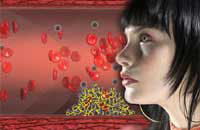Antiphospholipid syndrome is a disease based on the formation of antibodies to phospholipid components. The disease is manifested by thrombosis, obstetric pathology and a decrease in the number of blood platelets.
Content
Concept of antiphospholipid syndrome
Antiphospholipid syndrome - this disease is based on the development of autoimmune reactions to widespread phospholipid components present on the surface of platelets, vessel cells and nervous tissue. It is characterized by antiphospholipid triad syndrome:
- venous or arterial thrombosis
- Recognizing obstetric pathology
- thrombocytopenia (reducing the number of blood platelets)
Thrombosis with antiphospholipid syndrome due to the interaction of antiphospholipid antibodies with the cells of the vascular wall and a decrease in their activity to destroy thrombus. In addition, these antibodies suppress the synthesis of prostacyclin - substances that expands the clearance of blood vessels and prevents platelet gluing. Promotacylin synthesis suppression causes a thrombocyte bonding and promotes thrombosis. Thrombocytopenia (decrease in platelet concentration) develops as a result of the interaction of antibodies to phospholipids with platelets and their destruction.
Antiphospholipid syndrome is more often found in women than in men, at the age of 20-40 years, especially often develops with systemic red loll. Increasing the number of antibodies to phospholipids may occur in patients with rheumatoid arthritis, systemic scleroderma, SHEGREEN syndrome, as well as for malignant neoplasms, lymphoproliferative diseases, autoimmune thrombocytopenic purpura, against the background of viral, bacterial and parasitic infections, with a number of diseases of the central nervous system, reception of drugs causing the development of solo-like syndrome and in elderly. Primary antiphospholipid syndrome is considered in the absence of signs of diffuse diseases of the connective tissue.
Symptoms of antiphospholipid syndrome
Repeating thrombosis can be localized in any vessel (as a rule, it is rarely observed a single-stage thrombosis in venous and arterial vessels). Most often marked thrombophlebitis of deep veins of the heads. Light artery thromboembolism can develop. The vessel thrombosis of the central nervous system leads to the occurrence of acute violation of the cerebral circulation, coming by ischemic attacks, sometimes to transverse mixture, described the development of convulsive syndrome, chores and migraines.
The development of a mesh lidio (vascular grid in the form of bluetted spots, especially well detected during cooling), which is often combined with unstable arterial hypertension, is associated with thrombosis of fine skin vessels. The development of adrenal lack of adrenal glands, pulmonary hypertension, myocardial infarction, aseptic necrosis of the femur head, a thrombotic non-infective endocarditis with the damage of the heart valves (insufficiency or stenosis). Obstetric pathology is associated with vessel thrombosis of the placenta, causing the intrauterine fetal death and repetitive spontaneous abortions.
Diagnosis and treatment of antiphospholipid syndrome
 With a laboratory survey, a decrease in the number of blood platelets is determined, antibodies to cardiolipin, a lupus anticoagulant are found in serum, less often - a lipid exchange disorders are found.
With a laboratory survey, a decrease in the number of blood platelets is determined, antibodies to cardiolipin, a lupus anticoagulant are found in serum, less often - a lipid exchange disorders are found.
The patient antiphospholipid syndrome needs active treatment of the main disease. Treatment is aimed at reducing increased thrombosis, for which low doses of aspirin, dipyridamol, Tiklopidine are used. To reduce the amount of antibodies to antiphospholipids Low doses of glucocorticosteroids, plasmapheresis, aminohinoli-new derivatives. With antiphospholipid syndrome, a reception of oral contraceptives and smoking should be avoided, since these factors significantly take the course of the disease.









